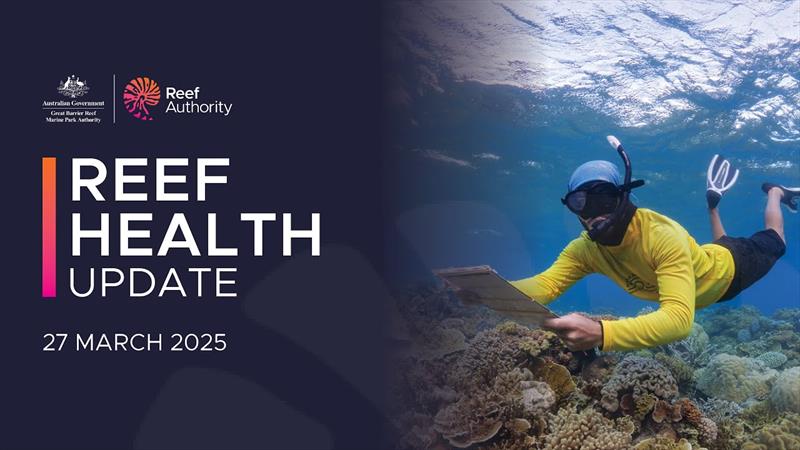
Great Barrier Reef Health update
by Great Barrier Reef Marine Park Authority 27 Mar 05:50 GMT
27 March 2025

Reef Health update | 27 March 2025 © Great Barrier Reef Marine Park Authority
As the lead managers of the Great Barrier Reef, the Reef Authority keeps an eye on the Reef year-round — with efforts stepped up over summer, a typically high-risk period from extreme weather.
The Reef Authority releases updates on the health of Reef which includes; sea surface temperatures, rainfall and floods, cyclones, crown-of-thorns starfish outbreaks, and coral disease.
These updates are based on forecasts, water temperature heat mapping, in-water surveys, citizen science and aerial surveys.
Reef Health update | 27 March 2025
Aerial surveys to date indicate coral bleaching is widespread but highly variable in the shallows of reefs across the Northern and Far Northern regions of the Great Barrier Reef Marine Park. Preliminary in-water surveys indicate there is also low levels of coral bleaching on surveyed reefs in the Central and Southern regions.
Aerial and in-water reports of coral bleaching are largely consistent with patterns of heat stress seen across the Reef with the Southern region comparatively unaffected by impacts from floodwaters and elevated sea surface temperatures.
Some central areas of the Reef have been impacted by flood plumes that reduced salinity levels causing coral bleaching and in the worst affected areas caused mortality on shallow-water corals at several inshore reefs, particularly in the Palm and Family Islands groups.
Results from the aerial and in-water surveys are being processed and will be released in the Summer Reef Snapshot next month.
Temperatures
While sea surface temperatures are forecast to remain around 1 degreesC above the long-term average for April, they are no longer at levels expected to cause further heat stress.
Over the past week, sea surface temperatures in the Far Northen region increased to 1.9 degreesC above the long-term average for March. Sea surface temperatures have increased by 0.5 degreesC to 1.2 degreesC above the March average in the Northern region and have decreased slightly to be 0.7 degreesC above the March average in the Central region. In the Southern region, temperatures increased by 0.4 degreesC to 1.2 degreesC above the March average.
Rainfall
The Bureau forecasts above average rainfall for North Queensland in the coming week. This could lead to continued flooding and freshwater intrusion in the Marine Park for the Far Northern, Northern and Central regions. Rainfall is forecast to be higher than usual over all Marine Park catchment areas in April, potentially further reducing sea surface temperatures.
Reef health
A total of 440 in-water Reef Health and Impact Surveys (RHIS) were conducted across the Marine Park in the fortnight from 6 to 20 March. Coral bleaching was reported on 23 of the 31 reefs surveyed (74%).
This including mostly low (1-10% prevalence) to medium-level (11-30% prevalence) coral bleaching in the Northern region. Reports of either no coral bleaching or low-level bleaching (1-10% prevalence) were received from the Central and Southern regions. No in-water data were available for the Far Northern region during this survey period.
Targeted in-water surveys conducted at eight reefs between Townsville and Airlie Beach revealed very low to medium-level bleaching, with mortality due to flood impacts present on the shoreward shallows of one reef located near the Burdekin River mouth. The remainder of the reefs had very low levels of mortality.
The Crown-of-Thorns Starfish (COTS) Control Program and Reef Joint Field Management Program have actioned 187 reefs for surveillance and culling of the coral-eating crown-of-thorns starfish so far this financial year (to 14 March). The program provides valuable information on Reef condition and impacts such as temperature stress and flood plumes.
Crown-of-thorns starfish outbreaks are impacting reefs throughout the Marine Park but are most severe in the Southern region (Swains Reefs) and between Port Douglas and Lizard Island. Cull operations are currently active at 43 reefs to suppress starfish outbreaks and protect coral.
COTS are at sustainable levels for coral growth and recovery on 112 of the 187 actioned reefs (60%).
Reef management
Over the coming week, Reef Authority and Queensland Parks and Wildlife Service staff, as part of the Reef Joint Field Management Program, will conduct in-water surveys between Innisfail and Cooktown to assess impacts from heat stress and flood plumes on coral reef communities.
The Reef Authority and COTS control program partners are meeting later this week to refine cull targeting to maximise the protection of coral habitats including those affected by coral bleaching, flood, and cyclone damage over the past two years.
The Reef Authority continues to partner with the tourism industry, government, science, and university data collectors to ensure access to the most up-to-date data across the World Heritage Area.
Our management actions build and support Reef resilience and include enforcing compliance with the Reef's zoning plan and ensuring people are enjoying the Reef in a responsible way.